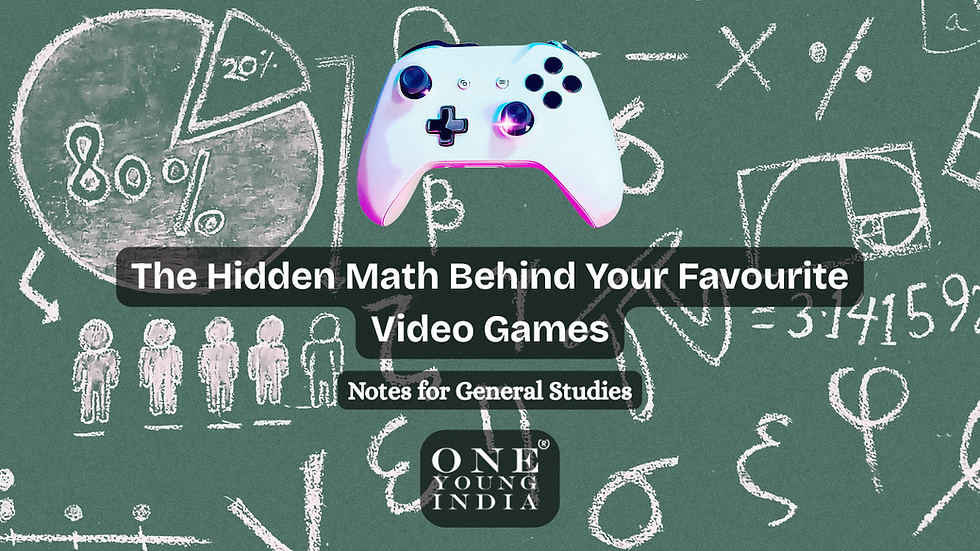The Hidden Math Behind Your Favourite Video Games
- One Young India

- Jul 25, 2025
- 6 min read
When you plunge into the vibrant worlds of God of War, The Legend of Zelda, or Call of Duty, the last thing on your mind is likely mathematics. The battles are fierce, the landscapes vast, the characters dynamic. It feels natural—effortless. But this immersive experience isn’t spontaneous. It’s carefully constructed through layers of complex systems, all grounded in mathematics.

Behind every headshot, gravity-defying leap, or randomly generated dungeon is a world of algorithms, geometry, and physics engines working in perfect harmony. It’s this hidden math that makes modern video games not just playable but deeply engaging and believable.
Let’s step behind the screen and uncover the invisible equations that make your favorite video games tick.
The Foundations: Math as the DNA of Digital Worlds
At their core, video games are software—mathematical systems designed to simulate experiences. Every object, character, and interaction is encoded with values and governed by rules, many of which are mathematical in nature.
From basic arithmetic and algebra to complex calculus and linear algebra, developers rely on math to create motion, design challenges, and build logic that responds to players' actions. While a casual gamer may never notice, math is what makes the virtual world behave in a way that feels intuitive and compelling.
1. Algorithms: Decision-Makers Behind the Scenes
In gaming, algorithms serve as the logic engines—the “thinking” part of the system. Whether determining how an enemy reacts, how a map is generated, or how a puzzle is solved, algorithms dictate game behavior.
A. Pathfinding and AI Logic
One of the most common algorithmic systems used in games is pathfinding. This enables characters—especially non-playable characters (NPCs)—to move logically through the game world.
The most widely used pathfinding algorithm is A* (A-Star). It calculates the most efficient path from point A to point B, considering obstacles and terrain. This is what allows an enemy in Assassin’s Creed to follow you through a maze of alleyways or lets a soldier in Halo take cover intelligently during a firefight.
Beyond pathfinding, AI behavior is shaped by algorithms that evaluate probabilities, patterns, and player behavior. Games like The Last of Us Part II or F.E.A.R. are lauded for their enemy AI not just because it looks smart—but because underneath, algorithms are constantly calculating the best possible responses to your actions.
B. Procedural Generation: Infinite Possibilities
Procedural generation is a technique where content is created algorithmically rather than manually. Games like Minecraft, No Man’s Sky, and Spelunky use this method to craft vast, unpredictable worlds.
This is achieved using random number generation and noise functions like Perlin noise to create varied landscapes and structures. But it’s not true randomness—developers use mathematical constraints to ensure that what’s generated is still meaningful and playable.
Procedural algorithms allow for both unpredictability and structure, giving players a fresh experience every time without compromising game balance.
2. Geometry and Trigonometry: The Language of Space and Motion
How does a character know where to stand? How does a projectile arc through the sky? The answer lies in geometry and trigonometry, which underpin spatial relationships and motion within game worlds.
A. Vectors: The Building Blocks of Movement
Every game element that moves—whether a bullet, car, or human avatar—relies on vectors. A vector is a quantity that has both direction and magnitude. In games, they are used to define position, velocity, and acceleration in two or three dimensions.
For example, if a character is sprinting diagonally, the game calculates the resulting vector by adding horizontal and vertical components. Wind resistance, momentum, and inertia are all modeled through vector math.
Vectors also come into play in handling collision detection, lighting angles, and even how a camera follows a player.
B. Angles and Rotations
Trigonometric functions such as sine, cosine, and tangent are essential in games involving rotation, camera movement, and aiming mechanics.
In a first-person shooter, your field of view (FOV) is defined by angular calculations. When you turn your character’s head, the camera rotates along an axis, with trigonometric equations adjusting the visible frame. In 3D games, these calculations become more intricate with the introduction of quaternions to avoid gimbal lock (a loss of rotational degrees of freedom).
3. Physics Engines: Simulating Reality
What makes a game world feel “real”? The way objects fall, bounce, break, or respond to your touch is governed by physics engines, which are themselves driven by mathematics—primarily Newtonian physics, dynamics, and kinematics.
A. Forces and Motion
Physics engines replicate the real-world behavior of objects using mathematical equations. These include:
F = ma (Force = Mass × Acceleration)
v = u + at (final velocity)
d = ut + ½at² (displacement)
When you jump off a ledge in Uncharted, these equations determine how fast you fall, how far you land, and whether you survive the impact. When a grenade explodes in Call of Duty, force vectors radiate outward, applying realistic knockback to everything in range.
Games may exaggerate or simplify real-world physics, but the underlying math is always there, dictating interactions and preserving immersion.
B. Collision Detection and Response
Collision detection determines when two game entities intersect—be it a car hitting a wall or a sword clashing against a shield.
Simple methods involve bounding boxes or bounding spheres that approximate the shape of objects. More advanced systems use mesh colliders that trace the exact surface.
Once a collision is detected, the game must resolve it—preventing characters from passing through walls or causing damage. This is achieved by applying opposing force vectors or adjusting object positions in real-time using equations of motion.
4. Game Balancing: The Math of Fair Play
Ensuring a game is neither too easy nor impossibly hard is an art backed by math. Game designers use probability, statistics, and data analysis to fine-tune every element from enemy spawn rates to loot drops.
A. Probability and Random Events
In RPGs or roguelikes, outcomes often hinge on probability. Will that critical hit land? Will you find rare loot in the next chest? These chances are calculated using random number generators (RNGs) and probability distributions.
The concept of drop rate—the likelihood of getting a specific item—is often tuned using binomial or Poisson distributions to balance excitement with fairness.
B. Damage Calculations
Many games use formulas to determine how much damage an attack deals. Consider an RPG where damage is calculated using:
Damage = (Attack Power × Skill Modifier) – (Defense × Resistance Multiplier)
These formulas can grow incredibly complex, incorporating elemental effects, critical hits, armor penetration, and buffs/debuffs. Game designers constantly tweak these values using data analytics to maintain competitive balance.
5. Rendering and Graphics: Math in Every Frame
Even the visual spectacle of a game is powered by mathematics. Linear algebra and matrix transformations are essential in rendering 3D graphics.
A. Coordinate Transformations
To display a 3D object on a 2D screen, games perform a series of matrix transformations:
Model Matrix: Places the object in the game world
View Matrix: Determines the camera’s point of view
Projection Matrix: Converts 3D space into 2D
These matrices are multiplied together to compute the final position of each vertex. The process happens dozens of times per frame, often 60 or more times per second.
B. Lighting and Shading
Lighting systems also rely on math. The Phong reflection model, for example, uses vectors and dot products to calculate the way light reflects off surfaces, giving the illusion of depth and material texture.
Shaders—small programs that run on the GPU—execute these calculations in real-time, relying heavily on trigonometry, calculus, and geometry.
Conclusion: The Silent Architect of Fun
It’s easy to see video games as digital playgrounds or cinematic adventures. But beneath every moment of awe, every near miss, and every plot twist, lies a silent architect: mathematics.
Without algorithms, you wouldn’t have smart enemies. Without physics engines, your environment would feel flat. Without geometry, you wouldn’t move smoothly through space. And without probability and balance, your victories would feel hollow or unearned.
Math is not just behind the scenes—it is the scene. It is the code that makes the fantasy real, the logic that breathes life into pixels, and the invisible hand that turns imagination into interaction.
So the next time you dodge a bullet in Red Dead Redemption 2, marvel at the terrain in Elden Ring, or pull off a perfect combo in Street Fighter, take a moment to appreciate the equations dancing just beneath the surface.



